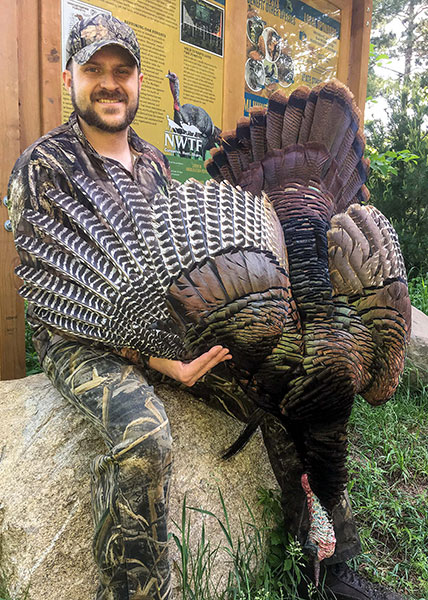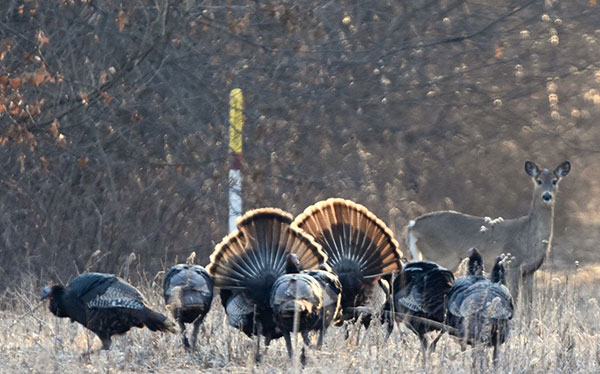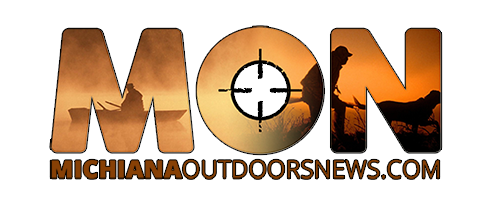- Details
By CASEY WARNER, Michigan Department of Natural Resources
 Hunter with nice wild turkey
Hunter with nice wild turkey
Hearing wild turkeys gobbling and clucking as you step out into the backyard early in the morning is common for many Michiganders now, but it wasn’t always so.
As we mark the annual holiday that revolves around turkey, let’s look back and celebrate these birds’ remarkable return from near extinction, often called one of the country’s greatest wildlife conservation success stories.
There are more than 6 million wild turkeys in the United States today, but seeing – or hearing – one was rare as recently as 50 years ago.
In Michigan, wild turkeys had been plentiful prior to the arrival of settlers, with an estimated 94,000 in the state at that time.
By the 1950s, Michigan’s wild turkey population had disappeared due to unregulated hunting and habitat loss.
Bringing turkeys back from the brink
Thanks to the efforts of a committed cadre of conservationists over the last 70 years, 200,000 wild turkeys now call Michigan home. They can be found in parts of every Lower Peninsula county and areas of the Upper Peninsula.
By 1965, the turkey population had rebounded enough that hunting was allowed. Today Michigan ranks sixth in the nation for number of turkey hunters, with consistently high hunter success and satisfaction rates.
Michigan’s spring turkey season is open in every county, and fall hunting is open in many areas of the state.
- Details
IDNR Report
During the 2022 spring season, hunters harvested 12,531 wild turkeys in 91 of 92 Indiana counties. This spring’s harvest is only a 1.7% increase compared to that of the 2021 spring season. Like last year, only one county did not harvest any turkeys during this spring’s hunting season.
Spring harvests increased in 47 counties with seven counties exceeding 300 birds, compared to five in 2021. A total of 1,376 birds (11% of total harvest) were taken during the youth-only weekend prior to the regular season. The estimated number of hunters afield changed very little from 57,621 in 2021 to 57,459 in 2022, but estimated hunter success increased to 22% in 2022 compared to 21% in 2021 and 19% in 2020.
A detailed breakdown of spring harvest data, including previous seasons, is available on the wild turkey spring harvest data website.
- Details
IDNR Report
During the spring 2021 turkey season, hunters harvested 12,320 wild turkeys throughout 91 of Indiana’s 92 counties.
This was a 15% decrease from the 2020 harvest but was close to the average harvest (12,065 birds) between 2015 and 2019. The Indiana Spring Turkey Harvest Data shows the top county was Dearborn, with a total of 355 birds. During the youth-only weekend, hunters took 1,198 birds (9% of the harvest).
- Details
MDNR Report
Check spring turkey drawing results at Michigan.gov/DNRLicenses or call 517-284-9453 (WILD). Licenses can be purchased online or over the counter at license retailers.
Applied for a license but were not drawn? Mark your calendars! Hunters who were unsuccessful in the drawing can purchase a leftover license on Monday, March 14 at 10 a.m.
Didn’t apply for a license? Remaining leftover turkey licenses will go on sale to everyone Monday, March 21 at 10 a.m. Licenses are sold on a first-come, first-served basis. There is no guarantee that leftover licenses will be available for any hunt unit.
Looking for a license that provides flexible hunting options? Hunt 0234 might be for you. Learn more about this hunt and season dates in the 2022 Spring Turkey Digest.
- Details
IDNR Report
 Wild Turkeys
Wild Turkeys
Indiana DNR is accepting applications for reserved spring turkey hunts from Feb. 14 through March 14.
Hunters can apply online at on.IN.gov/reservedhunt by clicking "Apply for a reserved hunt" and entering their Customer ID. The online method is the only way to apply. Late entries will not be accepted.
Applicants must possess a valid hunting license for the species they wish to hunt. A valid spring turkey hunting license and game bird habitat stamp privilege, a comprehensive lifetime hunting license, comprehensive lifetime hunting and fishing license, or a resident youth hunt/trap combo license is required to hunt or call in wild turkeys in the spring season. Non-hunting partners who plan to call in wild turkeys must be properly licensed.
The application process is consolidated into the online services website, on.IN.gov/INHuntFish, along with licenses, CheckIN Game, and HIP registration. You do not need to have an online account to apply, so there is no need to log in.




